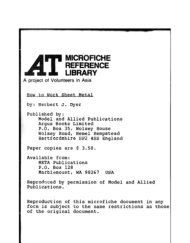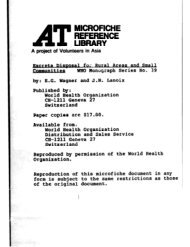Create successful ePaper yourself
Turn your PDF publications into a flip-book with our unique Google optimized e-Paper software.
‘\ .<br />
%.<br />
L<br />
‘\ i<br />
Two different<br />
reindeer-moss<br />
kinds of<br />
(Clodonia)<br />
h which are true lichens<br />
I 1 ‘I rather than mosses.<br />
.<br />
guish thc~rli fro111 v~lvh other ~nnd i clo’ilec+t<br />
them separately.<br />
-4<br />
Clonsider their ~rc~\\-th fornts, choler :lnd<br />
peel or tightly attached7 @cre they ntt:lcht!tf<br />
by ninny (*onncctors or a fe~y Y All<br />
are structural differences that may’ hdp<br />
size, and these characateristics will distin- seprate lichens.’ ApotherBt: the’ fruiting<br />
CTuish various ‘genera and spe&s. Separattl<br />
-~- structures” formed by-- the-’ fnquq-are<br />
---YGTErtpbY or ] 7ossiEe ide?ZfiGXoX~ cup-shaped projections iin’the upper SWlater<br />
date. I)y :Irld save them until ennu~:h face containing the fungal :spores. Some<br />
ltrr c*c>llrc*tcd for‘ dyeing. A small 11:1gf11l IiAclns 111tly hilve surcdi:l for pr~pagais<br />
3dccllmte for :t good snmple dycx ttlst. tion. These are aggregations of fungus<br />
Kinds .<br />
;Ln(l algal cells appearing as a powder on<br />
the surface or along the borders of the<br />
Three grorvtb forms +rr nlost apparent Ii&en plant body.<br />
among the lichens. Crrlstose ones -appear<br />
:I$ II fine crust or powder mainly on rocks<br />
Extraction<br />
or bark. Al’though they have dye possi’bil- Once the lichens are collected and i<br />
ities, they are imprnctiral to c~ollcct and dbied, the next concern will be to extract<br />
will be excluded from our concern. The their acids. Some acids are ensily extract-<br />
[olio.qe types nppe$g,lraf-like. In contrast<br />
to tllcse are the .fruticose f6rnls whjcll<br />
may have 1111 upright, stemlike growth<br />
habit. , :<br />
Kit11 thtlse distinctions-*in mind, concd<br />
by boiling as csplnined belo>v. Sincetblase<br />
acids arc afr&dy present i;l the<br />
lichen, they are often visible by the color<br />
of the lichdn. Many lichens with a yellow I<br />
or yellow-green tint often contain usnic<br />
.:<br />
j<br />
centrnte on the ~different fivticose and ;w.& -aad th-rough the boiling. m&hod a<br />
foliose forms. Noticenhle 3ize variations rust-yellow color range may be derived.<br />
may indicate different types. Turn the The genus Us9zea itself, a fruticose type,<br />
licahrn ~VPI’ and e%anline thr underside is rich in usnic acid. Most fruticose li-<br />
_<br />
that was attached to, the growing surface.<br />
Foliosf undersi,;l& are quite ,different<br />
chens sve good results when boiled. Oth-<br />
.c .._. _. -.. .----.---<br />
.<br />
er colii‘red lichens-mxy- impart similar<br />
frorll their upper sides, while less differ- dyes. It is of interest that some<br />
ence is present, in the fruticose types. mushrooms and other color4 fungi can ia.<br />
Consider how the li,chens were attached to ’ nlso yield dyes by this saqe method of<br />
the groming surface, Were they easy to<br />
30<br />
extraction. ’<br />
!<br />
L<br />
‘0<br />
.<br />
a<br />
l<br />
._ . . . . . . . . .._... :.“.<br />
I<br />
/<br />
’







